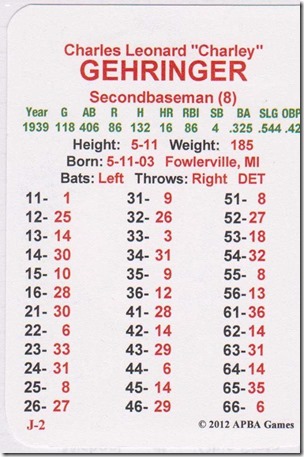Tom Goodell from Facebook’s APBA Baseball group has a quandary. Do you go with it? Or move the numbers to what you know is right?
I’ll be honest. It took me a couple minutes without a hint to realize what was wrong with this 1939 Charlie Gehringer card. It wasn’t until I looked at the most important number did I understand.
| Split | G | PA | AB | R | H | 2B | 3B | HR | RBI | SB | BB | SO | |||
|---|---|---|---|---|---|---|---|---|---|---|---|---|---|---|---|
| 1939 Totals | 118 | 487 | 406 | 86 | 132 | 29 | 6 | 16 | 88 | 4 | 69 | 16 | .325 | .424 | .544 |
Most likely, Gehringer’s total result numbers are all correct as is. The power numbers are just not in order.
So back to the original question… would you play this card as it is? Or would you “re-write” his card in APBA’s conventional order (perhaps a 66-1, 11-3, and a 33-6)?
Personally if I was doing a replay with this set, I would change the card. Especially if I was a Tigers fan. I’d hate to be rolling 66s on his card only to get a double each time.
In related news, I just found out that Gehringer was a Michigan alum. Go Big Ten!
thanks Tom!





By his stats, he should have only 4 power numbers. The result on 44 should be a 7. (51 XBs in 487 PA = 3.77 XBHs per 36 PA)
I’d play the card as is, if APBA hasn’t issued a correction.
Another “weird” thing about this card – only one 13! 16Ks in 487 PA. (The next year, only 17 Ks in 629 PA!!)